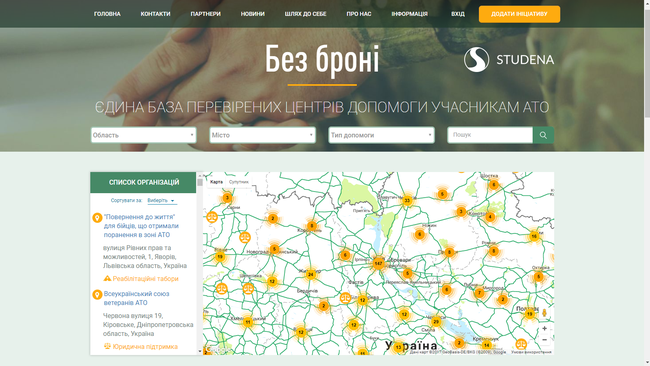NGO 'Studena" used PHP Yii2 framework and angular.js framework as key technologies for the website programming. Website coding lasted two months and cost around 2,000.00 USD. Content filling and development (information about organizations and services) took 12 months in total. The website was launched in March 2016, but its content is being updated on a regular basis. Later, the website was upgraded and became more user-friendly and suitable for a navigation on mobile devices. This upgrade cost around 2,000.00 USD, so in total, the budget spent is 4,000.00. This platform is not for profit purposes, but it is extremely valuable for service providers and target groups thanks to its unique content collected in one place.
The web-site is well known among veterans and service providers (organizations). According to NGO "Studena", there are numerous examples of veterans using the website. Placement on the website inspires and gives organizations credibility. The website is popular not only among veterans, it has also become a useful resource for social workers.
Profile and capacity of NGO "Studena" increased. Now "Studena" is one of the top five organizations providing psychological assistance to veterans. They used the project to build their capacity and networking. They collected data throughout the country and were able to identify gaps and to program accordingly. The NGO developed partnerships with key media, government, and civil society partners, and actively contribute to policy and legislation.
As of end-July 2017, the number of visitors exceeded 182,000.00 and a total number of users reached 58,558 persons.
Initially, the team has not foreseen high usage of the web platform through mobile devices, therefore the navigation on the website was complicated. Moreover, it required some overtime for download. After an upgrade, the platform became more user-friendly. Lesson learned: to take into account trends in devices' usage and, at least, for websites to create mobile versions. Despite these difficulties, the project became very popular.
Availability of relevant information close to users' locations is very convenient and can be applied in various projects. In addition, it helps to engage local initiatives and makes them visible to the target audiences, especially in conditions of limited information dissemination in small towns and villages. Moreover, the presence of local initiatives in informational space allows to encounter needs of users living in those areas.
